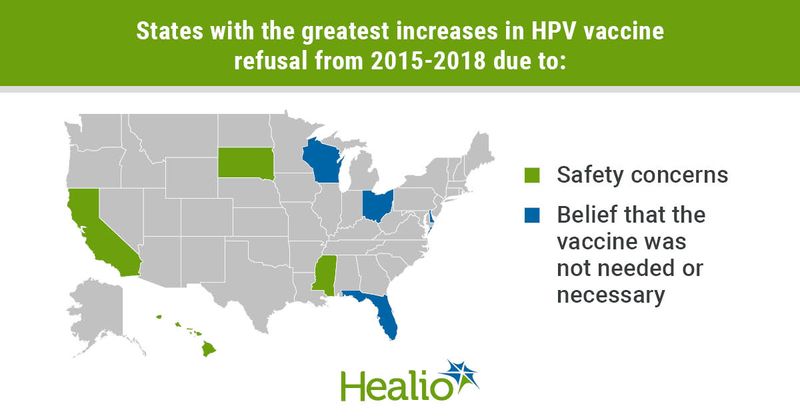Misinformation fuels significant increases in HPV vaccine refusal
Between 2015 and 2018, the proportion of parents and caregivers who refused the HPV vaccine for their adolescents due to safety concerns increased 79.9%, according to findings published in JAMA Network Open.
However, the rate of adverse events following receipt of the HPV vaccine decreased from 44.7 per 100,000 doses in 2015 to 29.4 per 100,000 doses in 2018, Kalyani Sonawane, PhD, an assistant professor of management, policy and community health at UTHealth School of Public Health in Houston, and colleagues wrote.

The researchers attributed the “negative perception of HPV vaccine safety” to vaccine misinformation on traditional and social media.
“We were surprised to see that misperceptions regarding the safety of the HPV vaccine have not improved despite the vaccine being licensed and recommended for more than a decade now,” Sonawane told Healio Primary Care. “Instead, HPV vaccine safety concerns have increased in recent years.”

HPV vaccine hesitancy
Sonawane and colleagues conducted a cross-sectional analysis of data from the National Immunization Survey (NIS) and Vaccine Adverse Event Reporting System on adolescents aged 13 to 17 years.
The NIS data included responses from parents and caregivers of 39,364 unvaccinated adolescents. The mean age of adolescents was 15.57 years; 62.9% were white, 56.1% were male, 62.6% were privately insured and 79.3% were above the poverty level.
The rate of HPV vaccine refusal due to safety concerns increased from 13% (95% CI, 12.1-14) in 2015 to 23.4% (95% CI, 21.8-25) in 2018. This increase resulted in 259,157 adolescents not receiving the HPV vaccine due to safety concerns in 2018 compared with 170,046 in 2015, according to the researchers.
Despite a significant decrease in adverse events after HPV vaccination, safety concern was the primary reason for vaccine hesitancy among parents and caregivers in 30 states. The researchers observed a 200% or more increase in safety concerns in:
- California, from 3.5% (95% CI, 0.2-6.9) to 20.5% (95% CI, 11.1-29.8);
- Hawaii, from 5.8% (95% CI, 2.1-9.6) to 20.9% (95% CI, 12.3-29.5);
- South Dakota, from 7.8% (95% CI, 4-11.5) to 26.6% (95% CI, 17.7-35.6); and
- Mississippi, from 8.1% (95% CI, 1.9-11.9) to 24.4% (95% CI, 17-31.9).
In addition, there were significant increases in the proportion of parents and caregivers who refused the HPV vaccine for their adolescents because they thought it was not needed or necessary. The largest increases occurred in:
- Delaware, from 16.3% (95% CI, 9.3-23.3) to 34.1% (95% CI, 22.6-45.7);
- Washington, D.C., from 13.7% (95% CI, 7-20.4) to 32.7% (95% CI, 17.9-47.5);
- Florida, from 18% (95% CI, 11.3-24.7) to 29.3% (95% CI, 20.8-37.9);
- Ohio, from 17.8% (95% CI, 11.7-24) to 28.4% (95% CI, 20-36.9); and
- Wisconsin, from 19.8% (95% CI, 13.6-26.1) to 34.3% (95% CI, 24.9-43.7).
“Tackling vaccine misinformation should be a priority at a national level and in physicians’ offices,” Sonawane said. “We need rigorous campaigns in the U.S. to improve vaccine acceptance. Providers should be trained in having effective vaccine conversations with parents and debunking any myths.”
It is hard to predict whether vaccine hesitancy will dramatically decrease in the coming years, she added.
“What we are seeing with COVID vaccines is that one negative tweet from a celebrity can change public opinion. Misinformation spreads faster than facts,” she said. “As a public health researcher, I wish vaccine hesitancy decreases, but we will have to continue to monitor public sentiment on vaccines in coming years.”
‘Epidemic of disinformation’
In a related commentary, Nosayaba Osazuwa-Peters, PDS, PhD, MPH, CHES, an assistant professor of global health, population health sciences and head and neck surgery at Duke University, Rebecca L. Rohde, MD, MPH, of the department of otolaryngology and communication science at the Medical College of Wisconsin, and Eric Adjei Boakye, PhD, an assistant professor in the department of population science and policy at Southern Illinois University School of Medicine, discussed how doubts surrounding the safety of the HPV vaccine have largely been fueled by social media.
“Studies have shown that while individuals trust medical professionals for health information, a growing number are turning to the internet for first and second opinions about HPV, HPV vaccines and HPV-associated cancer,” they wrote. “Much of the information available on the internet, including social media, is not peer-reviewed or
evidence-based, and unfortunately, information warning about the HPV vaccine is often based on half-truths or is completely baseless.”
Osazuwa-Peters, Rohde and Boakye noted that Sonawane and colleagues’ study illustrates a current “epidemic of disinformation jet-fueled by social media.”
As more research is conducted on the safety and efficacy of the HPV vaccine, scientists, health care professionals and the public should communicate with others that the HPV vaccine is safe and can prevent cancer, the authors wrote.
References:
Osazuwa-Peters N, et al. JAMA Netw Open. 2021;doi:10.1001/jamanetworkopen.2021.25124.
Sonawane K, et al. JAMA Netw Open. 2021;doi:10.1001/jamanetworkopen.2021.24502.
